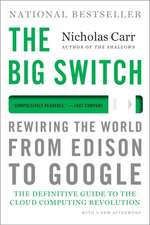A Concise Introduction to Data Compression: Undergraduate Topics in Computer Science
Autor David Salomonen Limba Engleză Paperback – 10 mar 2008
Divided into two parts, Part I presents the basic approaches to data compression and describes a few popular techniques and methods that are commonly used to compress data. The reader discovers essential concepts, such as variable-length and prefix codes, statistical distribution and run-length codes. Part II concentrates on advanced techniques, such as arithmetic coding, orthogonal transforms, subband transforms and Burrows-Wheeler transform.
Complete and clear, this book will be the perfect reference for advanced undergraduates in computer science and requires a minimum of mathematics. An author-maintained website provides readers with errata and auxiliary material.
Din seria Undergraduate Topics in Computer Science
- 20%
 Preț: 341.21 lei
Preț: 341.21 lei - 20%
 Preț: 233.75 lei
Preț: 233.75 lei - 20%
 Preț: 318.97 lei
Preț: 318.97 lei - 20%
 Preț: 306.58 lei
Preț: 306.58 lei - 20%
 Preț: 187.22 lei
Preț: 187.22 lei - 20%
 Preț: 192.73 lei
Preț: 192.73 lei - 20%
 Preț: 280.92 lei
Preț: 280.92 lei - 20%
 Preț: 287.02 lei
Preț: 287.02 lei - 20%
 Preț: 305.61 lei
Preț: 305.61 lei - 20%
 Preț: 258.78 lei
Preț: 258.78 lei -
 Preț: 334.88 lei
Preț: 334.88 lei - 20%
 Preț: 246.39 lei
Preț: 246.39 lei - 20%
 Preț: 384.11 lei
Preț: 384.11 lei - 20%
 Preț: 272.43 lei
Preț: 272.43 lei - 20%
 Preț: 316.07 lei
Preț: 316.07 lei - 20%
 Preț: 245.43 lei
Preț: 245.43 lei - 20%
 Preț: 376.75 lei
Preț: 376.75 lei - 20%
 Preț: 350.89 lei
Preț: 350.89 lei - 20%
 Preț: 306.71 lei
Preț: 306.71 lei - 20%
 Preț: 374.37 lei
Preț: 374.37 lei - 20%
 Preț: 225.02 lei
Preț: 225.02 lei - 20%
 Preț: 226.64 lei
Preț: 226.64 lei - 20%
 Preț: 375.53 lei
Preț: 375.53 lei - 20%
 Preț: 395.04 lei
Preț: 395.04 lei - 20%
 Preț: 307.16 lei
Preț: 307.16 lei - 20%
 Preț: 254.37 lei
Preț: 254.37 lei - 20%
 Preț: 227.15 lei
Preț: 227.15 lei - 20%
 Preț: 304.36 lei
Preț: 304.36 lei - 20%
 Preț: 336.99 lei
Preț: 336.99 lei - 20%
 Preț: 316.24 lei
Preț: 316.24 lei - 20%
 Preț: 304.12 lei
Preț: 304.12 lei - 20%
 Preț: 342.45 lei
Preț: 342.45 lei - 20%
 Preț: 276.82 lei
Preț: 276.82 lei - 20%
 Preț: 237.35 lei
Preț: 237.35 lei - 20%
 Preț: 374.20 lei
Preț: 374.20 lei - 20%
 Preț: 304.44 lei
Preț: 304.44 lei - 20%
 Preț: 297.28 lei
Preț: 297.28 lei - 20%
 Preț: 579.37 lei
Preț: 579.37 lei - 20%
 Preț: 298.18 lei
Preț: 298.18 lei - 20%
 Preț: 243.35 lei
Preț: 243.35 lei - 20%
 Preț: 302.80 lei
Preț: 302.80 lei - 20%
 Preț: 297.66 lei
Preț: 297.66 lei - 20%
 Preț: 300.89 lei
Preț: 300.89 lei - 20%
 Preț: 191.35 lei
Preț: 191.35 lei - 20%
 Preț: 278.10 lei
Preț: 278.10 lei - 20%
 Preț: 304.21 lei
Preț: 304.21 lei
Preț: 252.46 lei
Preț vechi: 315.58 lei
-20% Nou
Puncte Express: 379
Preț estimativ în valută:
48.31€ • 50.57$ • 39.97£
48.31€ • 50.57$ • 39.97£
Carte tipărită la comandă
Livrare economică 02-08 aprilie
Preluare comenzi: 021 569.72.76
Specificații
ISBN-13: 9781848000711
ISBN-10: 1848000715
Pagini: 326
Ilustrații: XIV, 314 p. 89 illus. With online files/update.
Dimensiuni: 178 x 235 x 41 mm
Greutate: 0.52 kg
Ediția:2008
Editura: SPRINGER LONDON
Colecția Springer
Seria Undergraduate Topics in Computer Science
Locul publicării:London, United Kingdom
ISBN-10: 1848000715
Pagini: 326
Ilustrații: XIV, 314 p. 89 illus. With online files/update.
Dimensiuni: 178 x 235 x 41 mm
Greutate: 0.52 kg
Ediția:2008
Editura: SPRINGER LONDON
Colecția Springer
Seria Undergraduate Topics in Computer Science
Locul publicării:London, United Kingdom
Public țintă
Lower undergraduateCuprins
Basic Concepts.- Approaches to Compression.- Huffman Coding.- Dictionary Methods.- Advanced Techniques.- Arithmetic Coding.- Image Compression.- Audio Compression.- Other Methods.
Recenzii
From the reviews:
"This book on data compression … can be considered an introductory one into a part of coding theory. … can be used by students who want to understand a general description of data compression and some of the important themes in this domain. … In each part exercises are provided, and solutions for them can be found at the end of the book. … Overall, the book … is particularly suitable for undergraduate students to be used for laboratory purposes." (Nicolae Constantinescu, Zentralblatt MATH, Vol. 1147, 2008)
"This book provides an overview of compression methods in general, and goes into a fair amount of detail for some specific algorithms in use. … On the whole, this could be a useful book for a short course on compression at the undergraduate level, and would provide students with a taste for the material." (Jeffrey Putnam, ACM Computing Reviews, December, 2008)
“In the present book, multiple explanations and examples are used to clarify and expose different and important concepts, such as entropy and variable length coding. The book also includes a numerous program code snippets. These programs are clearly written and so should be easily understood by students. The book is excellent and fills the stated goal. When I am going to teach data compression again, I will most definitely use A Concise Introduction to Data Compression as a textbook for the class.” (Ville Hautamäki, SIGACT News, April, 2012)
"This book on data compression … can be considered an introductory one into a part of coding theory. … can be used by students who want to understand a general description of data compression and some of the important themes in this domain. … In each part exercises are provided, and solutions for them can be found at the end of the book. … Overall, the book … is particularly suitable for undergraduate students to be used for laboratory purposes." (Nicolae Constantinescu, Zentralblatt MATH, Vol. 1147, 2008)
"This book provides an overview of compression methods in general, and goes into a fair amount of detail for some specific algorithms in use. … On the whole, this could be a useful book for a short course on compression at the undergraduate level, and would provide students with a taste for the material." (Jeffrey Putnam, ACM Computing Reviews, December, 2008)
“In the present book, multiple explanations and examples are used to clarify and expose different and important concepts, such as entropy and variable length coding. The book also includes a numerous program code snippets. These programs are clearly written and so should be easily understood by students. The book is excellent and fills the stated goal. When I am going to teach data compression again, I will most definitely use A Concise Introduction to Data Compression as a textbook for the class.” (Ville Hautamäki, SIGACT News, April, 2012)
Textul de pe ultima copertă
Compressing data is an option naturally selected when faced with problems of high costs or restricted space. Written by a renowned expert in the field, this book offers readers a succinct, reader-friendly foundation to the chief approaches, methods and techniques currently employed in the field of data compression.
Part I presents the basic approaches to data compression and describes a few popular techniques and methods commonly used to compress data. The reader discovers essential concepts, such as variable-length and prefix codes, statistical distributions and run-length encoding. Part II then concentrates on advanced techniques, such as arithmetic coding, orthogonal transforms, subband transforms and the Burrows-Wheeler transform.
Features:
• Clear overview of the principles underlying this field
• Outlines the essentials of the various approaches to compressing data
• Contains many learning aids such as: chapter introductions and summaries, chapter-end exercises, comprehensive glossary, etc.
• Provides several examples of important compression algorithms
• Offers a supplementary author-maintained website, with errata and auxiliary material – www.davidsalomon.name/DCugAdvertis/DCug.html
• An ideal introductory volume to David Salomon’s fourth edition of Data Compression: The Complete Reference
Complete and clear, this book is the perfect resource for undergraduates in computer science and requires a minimum of mathematics. It is also ideal for readers with a basic knowledge of computer science wanting to learn about data compression.
David Salomon is a professor emeritus of Computer Science at California State University, Northridge. He has authored numerous articles and books, including Coding for Data and Computer Communications, Guide to Data Compression Methods, Data Privacy and Security, Computer Graphics and Geometric Modeling, Foundations ofComputer Security, Transformations and Projections in Computer Graphics, and Variable-length Codes for Data Compression.
Part I presents the basic approaches to data compression and describes a few popular techniques and methods commonly used to compress data. The reader discovers essential concepts, such as variable-length and prefix codes, statistical distributions and run-length encoding. Part II then concentrates on advanced techniques, such as arithmetic coding, orthogonal transforms, subband transforms and the Burrows-Wheeler transform.
Features:
• Clear overview of the principles underlying this field
• Outlines the essentials of the various approaches to compressing data
• Contains many learning aids such as: chapter introductions and summaries, chapter-end exercises, comprehensive glossary, etc.
• Provides several examples of important compression algorithms
• Offers a supplementary author-maintained website, with errata and auxiliary material – www.davidsalomon.name/DCugAdvertis/DCug.html
• An ideal introductory volume to David Salomon’s fourth edition of Data Compression: The Complete Reference
Complete and clear, this book is the perfect resource for undergraduates in computer science and requires a minimum of mathematics. It is also ideal for readers with a basic knowledge of computer science wanting to learn about data compression.
David Salomon is a professor emeritus of Computer Science at California State University, Northridge. He has authored numerous articles and books, including Coding for Data and Computer Communications, Guide to Data Compression Methods, Data Privacy and Security, Computer Graphics and Geometric Modeling, Foundations ofComputer Security, Transformations and Projections in Computer Graphics, and Variable-length Codes for Data Compression.
Caracteristici
The author is experienced and has authored the very successful Data Compression: The Complete Guide, Fourth Edition Clear, reader-friendly style The required level of mathematics is minimal Specifically written for undergraduates, to cover foundations of Data Compression An author-maintained website, containing errata and auxiliary material complements the book Includes supplementary material: sn.pub/extras
















